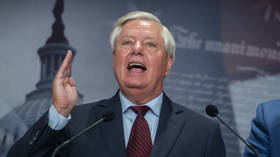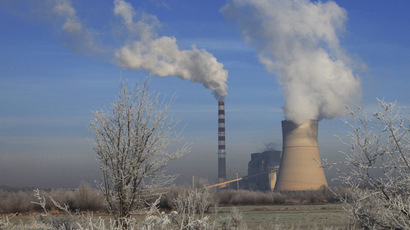UK wind farms outshine nuclear power output

UK wind farms generated more energy than the nation’s nuclear power stations on Tuesday thanks to a huge surge in gale-force winds in the wake of Hurricane Gonzalo, the National Grid has said.
While high winds and stormy weather caused disruption to UK flights, roads and rail links, causing one death and a spate of injuries, the renewable-energy industry found at least one silver lining amid the chaos.
During a 24 hour period on October 21, wind energy was responsible for 14.2 percent of the UK’s total generated energy, whereas nuclear power created 13.2 percent.
It's a tad windy! #HurricaneGonzalopic.twitter.com/yYC2BYgzqu
— Michael Pattinson (@MikePattinson) October 21, 2014
The feat follows another recent triumph for wind energy. According to the National Grid, turbines created 6,372 megawatts on October 18 – a record amount for wind energy – generating some 20 percent of the UK’s electricity, albeit during the weekend, a time when demand is relatively low.
Storm damage! Thanks to everyone who rallied round and helped at a difficult time. #HurricaneGonzalopic.twitter.com/abVHwSbQaq
— Elizabeth White (@lizwhiteart) October 22, 2014
Gonzalo, however, can’t take all the credit for wind power’s lion share over nuclear. Faults in some of the UK’s nuclear reactors, which have rendered eight out of a total 15 out of action, skewed the figures.
Nuclear reactors in Sizewell, Hunterston, Dungeness, Heysham and Hartlepool are all undergoing planned repair work, which has left the UK relying on less than 50 percent of regular nuclear output.

Wind farms are the cause of some controversy in rural areas, where residents frequently object to their construction in view of their properties. The government is seeking to restrict the areas in which new farms can be built.
In a speech on October 15 to the Global Warming Policy Foundation, former UK Environment Minister Owen Paterson urged ministers to scrap outlay on environmental technology and abandon the 2050 climate targets, claiming that investment is unsustainable.
Paterson condemned wind farms for “soaking up” subsidies and producing a “paltry” amount of power. He recommended directing funds to build a number of small nuclear power stations.
A government spokesperson, however, said that in order to continue meeting current climate targets there is a need to diversify energy sources, including renewables.
“We need a diverse energy mix that includes renewable sources like wind and solar alongside nuclear and technologies like carbon capture and storage so we can continue to use fossil fuels in a cleaner way,” they argued.
Jennifer Webster, a spokesperson for trade body RenewableUK, says wind farms have been unfairly panned as inefficient, expensive and ugly. Turbines have become an “easy whipping boy for political opponents and vested interests,” she said.
“[Wind power has] been quietly powering millions of homes across the UK and providing a robust response to its vocal detractors,” she added.
In a speech at the UN Climate Summit in September, Prime Minister David Cameron said climate change is “one of the most serious threats facing our world.”














